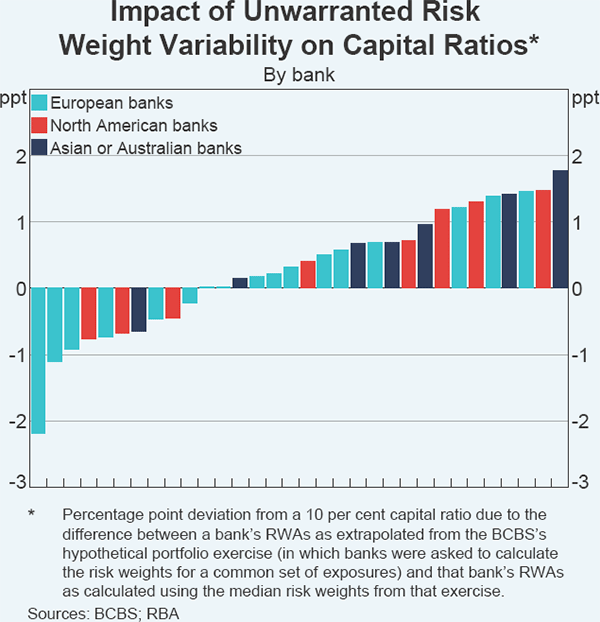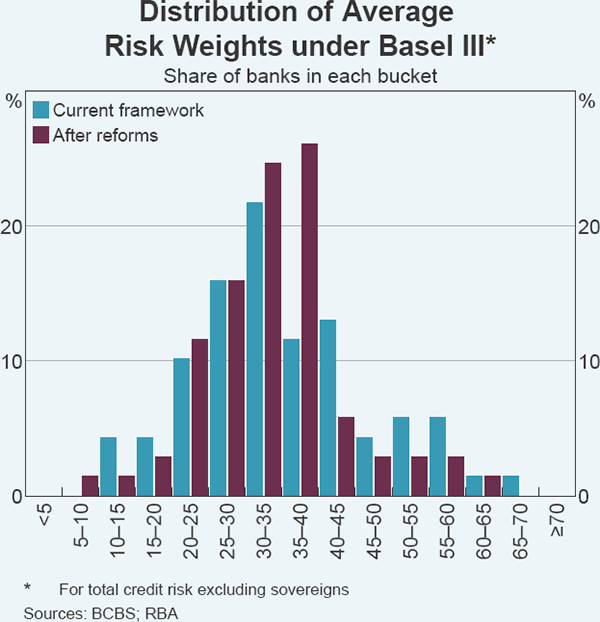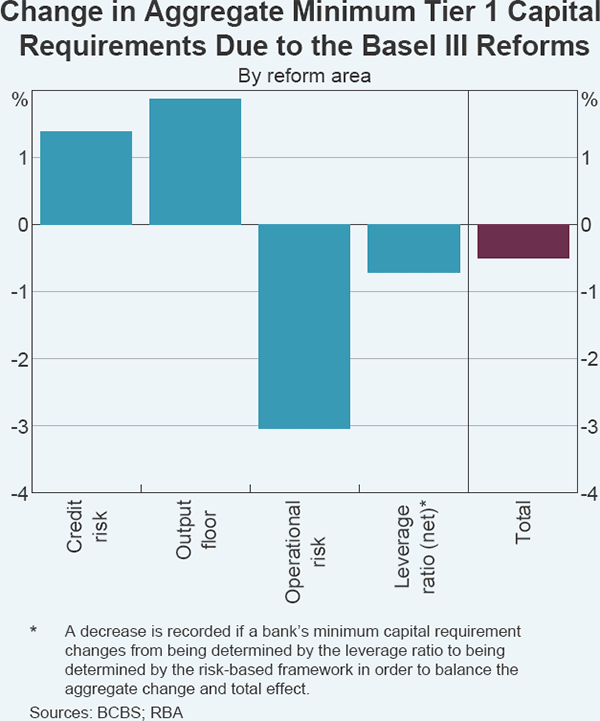Financial Stability Review – April 2018 Box E: Reforms to the Basel III Capital Framework
In response to the global financial crisis, the international Basel Committee on Banking Supervision (BCBS) developed the Basel III capital and liquidity framework with the objective of improving the resilience of the banking system. A core element of the framework was to significantly increase the amount of capital held by banks. The Basel III capital framework was agreed to in 2010 with implementation by jurisdictions starting from 2013. In monitoring the implementation of Basel III, however, the BCBS found significant variation in the value of risk weights calculated by banks, even among those with similar business models and risk profiles. This variability across banks can affect their capital ratios significantly, potentially undermining the objective of the framework (Graph E1). So over recent years, the BCBS has considered ways to reduce unwarranted variability in risk weights, as well as to increase the simplicity, comparability and risk sensitivity of the Basel III capital framework. In December, the Group of Central Bank Governors and Heads of Supervision – the oversight body of the BCBS – endorsed a package of reforms designed to achieve these goals. This box outlines the changes made to the Basel III capital framework, their likely effects, and the agreed implementation timeline. The Australian Prudential Regulation Authority (APRA) has issued a consultation paper on modifications to the domestic capital framework that take these reforms to Basel III into account. However, Australian banks are unlikely to need to raise additional capital due to these changes as they are already well capitalised.

Key Reforms to the Basel III Capital Framework
The BCBS agreed to several key changes to the following aspects of the Basel III capital framework.[1]
- The standardised approach for credit risk, which is the default method for calculating risk-weighted capital requirements. The revisions to this aspect of Basel III mostly focus on enhancing the risk sensitivity of the framework. One of the main changes to the standardised approach is the introduction of risk weights for commercial real estate, income-producing real estate and residential real estate exposures that increase with the loan-to-valuation ratio (LVR) of the loan.[2] More granular risk weights for exposures to banks and corporations have also been introduced.
- The internal ratings-based (IRB) approaches for credit risk, under which banks calculate their own risk weights for determining RWAs using internal models (rather than applying the risk weights set by the supervisor under the standardised approach). The revisions to Basel III impose additional constraints on these models by, first, introducing minimum values for some inputs and, second, reducing the number of inputs that can be estimated by banks. To model risk weights, banks estimate the probability of default, loss given default (LGD) and exposure at default (EAD) for certain exposures. The reforms impose a minimum value for each of these inputs depending on the nature of the exposure. For instance, banks will be required to use a minimum LGD of 5 per cent for residential mortgage exposures. The reforms also require banks to use supervisor-set estimates of LGD and EAD to calculate risk weights for financial institutions, and large and mid-sized corporations (instead of estimating these parameters using their internal models). The rationale for this change is that the LGD and EAD for these exposures are inherently unpredictable, which is likely to lead to significant variation in banks' estimates. These changes should accordingly increase the comparability of the framework by reducing variance in the risk weights generated by banks' models.
- The ‘output floor’, which places a limit on the benefit a bank derives from using its internal models for estimating regulatory capital. It requires that, to calculate capital requirements, IRB banks use the higher of total RWAs calculated using their internal models or 72.5 per cent of total RWAs calculated using only the standardised approach. Banks will also be required to disclose their total RWAs based on the standardised approach.
- The leverage ratio, which specifies a minimum level of capital to be held against total (rather than risk-weighted) assets. The main reform to this aspect of the framework is the introduction of a capital add-on, or buffer, for global systemically important banks (G-SIBs). A similar buffer is currently applied to G-SIBs under the risk-weighted capital framework, so this reform restores the relative incentives provided by both capital constraints for G-SIBs. The buffer applied to a G-SIB's leverage ratio is 50 per cent of the buffer applied to that G-SIB's risk-weighted capital requirement.[3] There are no Australian G-SIBs.
- The operational risk framework, which requires banks to hold capital against the risk of losses resulting from events such as fraud, misconduct fines and cyber attacks. The operational risk framework has been simplified, with the current modelled approach and the three standardised approaches for operational risk being replaced with a single risk-sensitive standardised approach. Under the new approach, a bank's operational risk capital requirement increases with its historical operational losses and income.
Effects of the Reforms
As discussed above, the primary objective of the recent reforms is to limit unwarranted risk weight variability within Basel III's broader goal of enhancing bank resilience. While the effects of the changes on risk weight variability can only be fully assessed after implementation, the results of the BCBS's pre-implementation quantitative assessment suggest that the distribution of average risk weights for large, internationally active banks will become more closely clustered around the mean (Graph E2).[4]

One objective of the BCBS has been to finalise the reforms without significantly increasing overall capital requirements. Accordingly, the reforms are projected to result in little change to aggregate minimum capital requirements, although for some banks capital requirements are likely to increase, while they will decrease for some others. For instance, the European Banking Authority (EBA) estimates that large European banks will need to accumulate €37 billion in additional capital in order to meet the new requirements.[5] Reforms to the output floor and the credit risk framework are expected to raise aggregate minimum capital requirements, but this is expected to be offset by lower capital requirements from revisions to the operational risk framework (Graph E3).

As with other BCBS policies, the detailed implementation of these reforms in individual countries may differ slightly from the framework described above in order to account for local circumstances. Domestically, APRA has stated that Australia is ‘well-equipped to accommodate the final Basel III framework’ and is currently consulting on the implementation of the reforms (for further detail see ‘The Australian Financial System’ chapter).[6] As noted earlier, the implementation of the reforms in Australia is unlikely to require the Australian banks to raise additional capital. APRA is not seeking to increase capital requirements beyond those announced in July 2017 as part of the ‘unquestionably strong’ benchmarks.
While the BCBS continues to refine some areas of the Basel III capital framework, the finalisation of the reforms largely marks the end of the main post-crisis rule-making effort by the BCBS. Its attention is now increasingly focused on monitoring the implementation of the reforms and assessing their effects.
Implementation
According to the international implementation timetable set by the BCBS, reforms to the standardised and IRB approaches for credit risk, the operational risk framework and the leverage ratio come into effect on 1 January 2022. Banks in BCBS member jurisdictions will have to meet the entire change in capital requirements arising from these reforms by this date. By contrast, the output floor will be phased in from 1 January 2022, starting at 50 per cent and increasing in stages until the final floor of 72.5 per cent is reached on 1 January 2027. However, individual jurisdictions have the discretion to implement the reforms at an accelerated pace.
During the implementation of the output floor, a ‘transitional cap’ may be applied at the discretion of the national supervisor. The transitional cap limits the overall increase in RWAs due to the implementation of the output floor to 25 per cent for an individual bank. This means that, during the phase-in period, a bank's minimum capital requirement could be capped at 1.25 times the requirement calculated before the application of the floor. The cap must be removed once the output floor is fully implemented in 2027, at which point banks given relief under the cap must meet the entire increase in capital requirements.
Footnotes
Note that some detailed elements of the framework are subject to national discretion. [1]
The LVR used for calculating the risk weight will decline over time as the loan is repaid. There is some supervisory discretion over how the value of the property can be adjusted, but generally it will be maintained at the value measured at origination unless an extraordinary, idiosyncratic event results in a permanent reduction in value. [2]
For example, a G-SIB subject to a two percentage point surcharge on its risk-weighted capital requirement would be subject to a one percentage point surcharge on its leverage ratio. [3]
See BCBS (2017), ‘Basel III Monitoring Report: Results of the cumulative quantitative impact study’, December, pp. 19–21. [4]
This estimate is for total capital. See EBA (2017), ‘Ad Hoc Cumulative Impact Assessment of the Basel Reform Package’, December, p. 5. [5]
See APRA (2017), ‘APRA welcomes finalisation of Basel III bank capital framework’, December. [6]